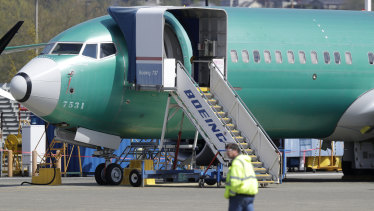Federal Aviation Administration officials have approached U.S. prosecutors to warn them that the lone person charged with a crime after the two fatal crashes of Boeing’s 737 MAX is being made a “scapegoat,” according to a court filing in the case.
Statements by the US Department of Justice after it indicted Mark Forkner, Boeing’s former chief technical pilot, last October contained “many errors in fact,” according to an email and a presentation given to prosecutors by the FAA employees. The case’s focus on Forkner’s actions in the wake of the crashes is “incorrect and misguided,” the FAA officials said.

The 737 MAX, once Boeing’s best-selling aircraft, was grounded for 20 months after two crashes killed 346 people.Credit:AP
The unusual assertions by FAA officials, which could substantially undercut the prosecution’s case, were detailed in a motion by Forkner’s lawyers filed on Monday in a Texas court asking a judge to order access to the officials as potential witnesses in the case.
One unnamed FAA official approached prosecutors on October 26, 12 days after Forkner was indicted, to request a meeting, said the motion by Forkner lawyers Jeff Kearney, Catherine Stanley and David Gerger.
“Forkner, he said, is a ‘scapegoat’ and should ‘not be charged,’” the lawyers said in the motion.
In a PowerPoint presentation by FAA officials, with the agency’s logo prominently attached to each page, they say alleged “smoking gun” evidence isn’t relevant to the case, and Forkner’s role in developing pilot-training for the MAX played no role in the FAA’s decision to certify the plane or the design errors that led to the crashes.
The information throws new uncertainty into the Forkner case and the narrative of the 737 MAX saga, which prompted a 20-month grounding of Boeing’s best-selling aircraft and led to billions in losses for the planemaker. It also comprises some of the most detailed explanations about what US regulators believe went wrong in the 737 MAX’s approval.
Crashes off the coast of Indonesia and in Ethiopia within about four months in 2018 and 2019, which killed 346 people, were triggered in part by failures that caused the jets to automatically nosedive repeatedly. In both cases, pilots didn’t perform a procedure that would have disabled the errant system, and they eventually lost control of the planes.








